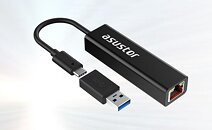- Joined
- Oct 9, 2007
- Messages
- 47,709 (7.42/day)
- Location
- Dublin, Ireland
| System Name | RBMK-1000 |
|---|---|
| Processor | AMD Ryzen 7 5700G |
| Motherboard | Gigabyte B550 AORUS Elite V2 |
| Cooling | DeepCool Gammax L240 V2 |
| Memory | 2x 16GB DDR4-3200 |
| Video Card(s) | Galax RTX 4070 Ti EX |
| Storage | Samsung 990 1TB |
| Display(s) | BenQ 1440p 60 Hz 27-inch |
| Case | Corsair Carbide 100R |
| Audio Device(s) | ASUS SupremeFX S1220A |
| Power Supply | Cooler Master MWE Gold 650W |
| Mouse | ASUS ROG Strix Impact |
| Keyboard | Gamdias Hermes E2 |
| Software | Windows 11 Pro |
ASUSTOR, the NAS-focused brand of ASUS, unveiled the AS-U2.5G2, a pocket-size external network adapter for 2.5 Gbps Ethernet. Built into a premium casing made of aluminium, the adapter uses a Realtek RTL8156B 2.5 GbE PHY, which is a single-chip solution designed for USB 3.0, without the need for a USB-to-PCIe bridge chip. A single USB 3.2 Gen 1 connection handles both power and host-connectivity. The adapter comes with a convenient USB type-C connector, and a type-C to type-A dongle is included. It measures 16.4 (H) x 23.4 (W) x 195.2 (D) mm, and weighs just 33 g. Since it's being sold standalone, it's compatible with not just ASUSTOR NAS products, but also any Windows 10 PC. The company didn't reveal pricing.

View at TechPowerUp Main Site

View at TechPowerUp Main Site



